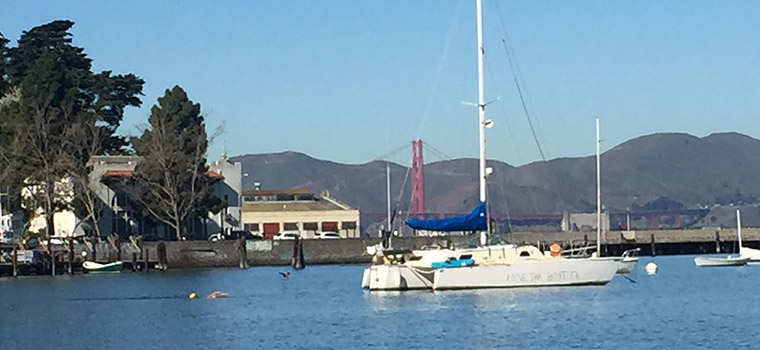For months, a rundown sailboat has been illegally anchored in San Francisco Bay's most sheltered swimming cove, Aquatic Park, off San Francisco's northern shoreline.

For months, a rogue sailboat has been anchored in the swimming lanes at San Francisco’s Aquatic Park, polluting the water with human waste. Photo by Sejal Choksi-Chugh
BY SEJAL CHOKSI-CHUGH
Published: April, 2018
For months, a rundown sailboat has been illegally anchored in San Francisco Bay’s most sheltered swimming cove, Aquatic Park, off San Francisco’s northern shoreline.
Swimmers have called and emailed Baykeeper’s Pollution Hotline repeatedly to report pollution from the rogue sailboat. They reported having to detour around the boat because it was anchored in the swimming lanes. Most disturbingly, they told us they’ve been swimming through human waste the boat’s occupant had dumped overboard.
Permits are required for boats to anchor in Aquatic Park Cove, which is part of San Francisco Maritime National Historic Park. The maximum stay is five nights in a row or 30 days in a year. This sailboat never obtained a permit, and it’s been in the cove for more than four months.
So why hasn’t local law enforcement been able to remove a public nuisance that is flouting the law and endangering the health of people and wildlife?
Sadly, this boat in the Bay’s iconic swimming cove is an example of a much larger problem. Throughout San Francisco Bay and up into the Delta, hundreds of boats are deteriorating or abandoned, and are discharging harmful sewage, metals, trash, fuel and other pollution.
Getting these polluting boats out of the water and disposing of them in a way that doesn’t harm the environment can cost millions of dollars. The bureaucracy around boat removal can also be complex. Local agencies have limited legal authority that prevents them from confiscating private property and removing derelict boats. The Coast Guard can’t take action unless a boat poses a substantial navigation hazard. And the criminal process is a slow, single-boat solution that requires local law enforcement to find an owner to hold accountable.
In the case of the Aquatic Park Cove sailboat, for instance, despite involvement of the U.S. Park Service Police, San Francisco Police and the U.S. Coast Guard—and despite the fact that the boat operator is known—the rogue boat still hasn’t been removed.
The situation is further complicated when homeless persons—or people who can’t afford boat maintenance and proper waste disposal—squat on boats. That may be what’s been going on at Aquatic Park. It’s not clear whether the man living on the rogue sailboat has title to it. Whether he owns it or not, the matter is now in federal court. He could face jail time, but the National Park Service has told the media that they prefer he just leave the cove willingly.
San Francisco needs stronger regulations to protect our Bay waters from derelict and abandoned boats. To find lasting solutions, the Coast Guard recently convened a working group with Baykeeper, recreational boating groups and state and local agencies. We’re identifying the gaps in existing law and local authority. We are also exploring legislative and funding ideas by looking at boat removal programs in states like Florida, Washington and Oregon to determine what will work best here.
Our goal is for California agencies to have more tools to remove boats like the one in Aquatic Park quickly, before the pollution harms swimmers or hurts our beautiful Bay. To learn more about Baykeeper’s work to stop pollution in San Francisco Bay, visit us at baykeeper.org.
Sejal Choksi-Chugh is the executive director of San Francisco Baykeeper. Baykeeper uses on-the-water patrols of San Francisco Bay, science, advocacy and the courts to stop Bay pollution. To report pollution, call Baykeeper’s hotline at 1-800-KEEP-BAY (1-800-533-7229), e-mail hotline@baykeeper.org, or click “Report Pollution” at baykeeper.org.

